The Très Riches Heures du Duc de Berry (1416)
Introduction
We have selected an appropriate quotation from the works of members of the Scottish Enlightenment to go with the following illustrations from the Très Riches Heures. We have done this because the Très Riches Heures is a marvellous depiction of many aspects of social and economic life in Europe in the early 15th century and it was a feature of the Scottish Enlightenment to explore how European societies made the transition from a system of peasant agriculture dominated by an aristocratic class to a modern market society in which mass production and the division of labor satisfied the needs of consumers in a voluntary fashion.
For further reading see [clicking on the linked name of the month will take you to more details below]:
- School of Thought: The Scottish Enlightenment
- Henry Home, Lord Kames (January: the month of aristocratic gift giving and feasting)
- John Millar (February: peasants at work and keeping warm in winter)
- Adam Smith (March: preparing the fields and vineyards for the spring growing season)
- Henry Home, Lord Kames (April: the fields and vineyards are green and aristocratic lovers get ready for their wedding)
Note: Some of the illuminations painted for Berry's Book of Hours inspired some of the backdrops to sets used by Laurence Olivier in his film of Shakespeare's play Henry V which he made in 1944 on the eve of the Normandy invasion.
Source
Source: <http://de.academic.ru/dic.nsf/dewiki/1410388>
Additional Reading
Online resources:
 |
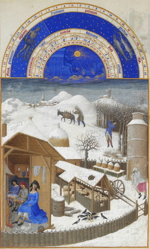 |
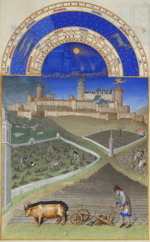 |
|
January
|
February
|
March
|
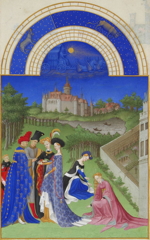 |
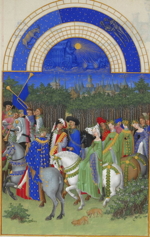 |
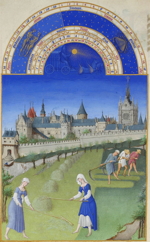 |
|
April
|
May
|
June
|
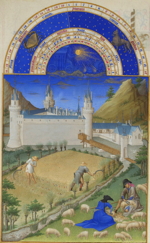 |
 |
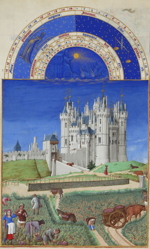 |
|
July
|
August
|
September
|
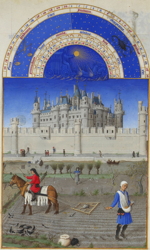 |
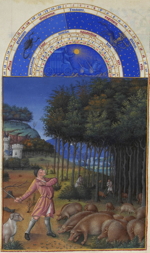 |
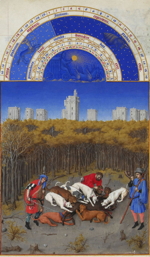 |
|
October
|
November
|
December
|
The Months of the Year
January: the month of aristocratic gift giving and feasting
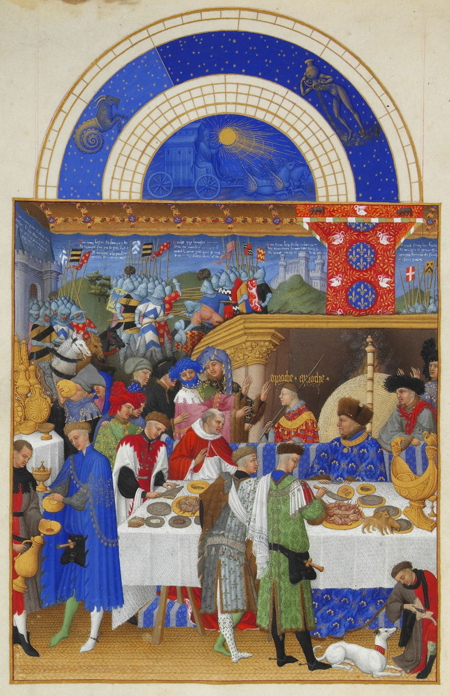 |
|
Illuminated page for the month of January from Les Très Riches Heures du Duc de Berry (1416)
|
Description
January was a month of gift giving and we can see some of the wealthy friends of the Duke de Berry bringing new year's gifts to their lord (who can be seen seated on the right at a banquet table in a striking blue robe decorated with gold fleurs de lys - indicating his support for the French monarchy). He sits before a large fire which warms the group from the January cold. Behind him and to the right are two young men wearing black head gear who may be the Limbourg brothers who painted these scenes under the patronage of the Duke de Berry. On the wall behind the revellers is a large tapestry which shows a scene from the Trojan War (although the soldiers are dressed in 15th century uniforms). It might also be a reference to the war which was currently being fought against King Henry V of England who defeated the French at the Battle of Agincourt in 1415.
Quotation: Henry Home, Lord Kames, on the "Progress and Effects of Luxury" among the aristocracy.
Feasts in former times were carried beyond all bounds. William of Malmsbury, who wrote in the days of Henry II. says, “That the English were universally addicted to Drunkenness, continuing over their cups day and night, keeping open house, and spending the income of their estates in riotous feasts, where eating and drinking were carried to excess, without any elegance.” People who live in a corner imagine that every thing is peculiar to themselves: what Malmsbury says of the English is common to all nations, in advancing from the selfishness of savages to a relish for society, but who have not yet learned to bridle their appetites. Giraldus Cambrensis, speaking of the Monks of Saint Swithin, says, that they threw themselves prostrate at the feet of King Henry II. and with many tears complained, that the Bishop, who was their abbot, had withdrawn from them three of their usual number of dishes. Henry, having made them acknowledge that there still remained ten dishes, said, that he himself was contented with three, and recommended to the Bishop to reduce them to that number. Leland (a) mentions a feast given by the Archbishop of York, at his installation, in the reign of Edward IV. The following is a specimen: 300 quarters of wheat, 300 tons of ale, 100 tons of wine, 1000 sheep, 104 oxen, 304 calves, 304 swine, 2000 geese, 1000 capons, 2000 pigs, 400 swans, 104 peacocks, 1500 hot venison pasties, 4000 cold, 5000 custards, hot and cold. Such entertainments are a picture of manners. At that early period, there was not discovered in society any pleasure but that of crowding together in hunting and feasting. The delicate pleasures of conversation, in communicating opinions, sentiments, and desires, were to them unknown. There appeared, however, even at that early period, a faint dawn of the fine arts. In such feasts as are mentioned above, a curious desert was sometimes exhibited, term-ed sutteltie, viz. paste moulded into the shape of animals. On a saint’s day, angels, prophets, and patriarchs, were set upon the table in plenty. A feast given by Trivultius to Lewis XII. of France, in the city of Milan, makes a figure in Italian history. No fewer than 1200 ladies were invited; and the Cardinals of Narbon and St. Severin, with many other prelates, were among the dancers. After dancing, followed the feast, to regulate which there were no fewer employed than 160 master-households. Twelve hundred officers, in an uniform of velvet, or satin, carried the victuals, and served at the side-board. Every table, without distinction, was served with silver-plate, engraved with the arms of the landlord; and beside a prodigious number of Italian lords, the whole court, and all the household of the King, were feasted. The bill of fare of an entertainment given by Sir Watkin Williams Wynn to a company of 1500 persons, on his coming of age, is a sample of ancient English hospitality, which appears to have nothing in view but crowding and cramming merely. The following passage is from Hollinshed: “That the length and sumptuousness of feasts formerly in use, are not totally left off in England, notwithstanding that it proveth very beneficial to the physicians, who most abound where most excess and misgovernment of our bodies do appear.” He adds, that claret, and other French wines, were despised, and strong wines only in request. The best, he says, were to be found in monasteries: for “that the merchant would have thought his soul would go straightway to the devil, if he should serve monks with other than the best.” Our forefathers relished strong wine, for the same reason that their forefathers relished brandy. In Scotland, sumptuous entertainments were common at marriages, baptisms, and burials. In the reign of Charles II. a statute was thought necessary to confine them within moderate bounds.
Source: Henry Home, Lord Kames, Sketches of the History of Man Considerably enlarged by the last additions and corrections of the author, edited and with an Introduction by James A. Harris (Indianapolis: Liberty Fund, 2007). 3 Vols. Vol. 1. Chapter: SKETCH VII: Progress and Effects of Luxury </title/2032/144945/2711152>.
February: peasants at work and keeping warm in winter
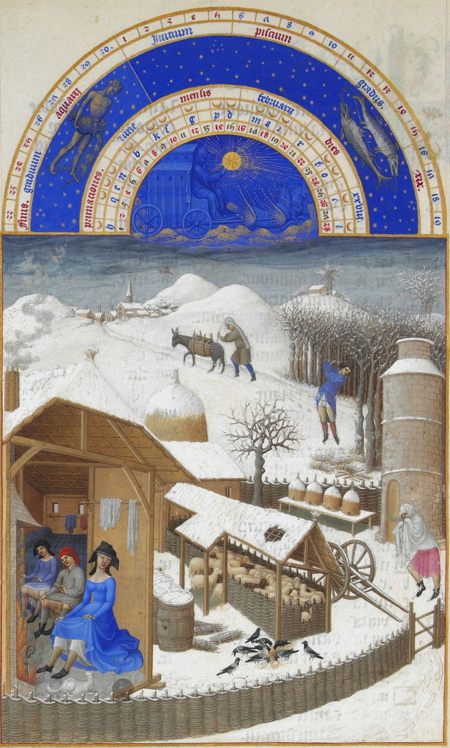 |
|
Illuminated page for the month of February from Les Très Riches Heures du Duc de Berry (1416)
[See a larger image of this image] |
Description
In striking contrast to January where we see a gathering of aristocrats for gift giving and feasting, in the image for February we see a group of peasants going about their winter chores and warming themselves by a fire. The taxes they pay to the aristocratic landowners make possible the feasting they are enjoying so much above. In the background we can see a grey sky and a snow-covered village. Two men are at work: one walks behind a donkey which is laboring up the hill, and another is chopping firewood. In the middle ground we can see a number of objects which contribute to the peasant economy: a snow covered haystack, 4 beehives, and a dovecote. In the foreground we can see a sheep pen with sheep hunddling together for warmth, and a group of birds (doves or magpies) pecking some seeds which have been strewn on the ground. Seeking warmth is also the theme of the 4 people in the foreground. A cut away picture of a peasant's home shows a couple sitting by the fire with their pants and skirt hitched up in order to warm their legs. As in the image for January we see them with their hands raised towards the fire in a gesture of hand warming. A better dressed woman in a blue dress is shyly looking away as she too discreetly lifts her dress (only half way up) to warm herself. To the right a fourth person wrapped in a shawl is hurrying towards the house and its warm fire.
Quotation: John Millar, on the "Causes of the freedom acquired by the labouring people in the modern nations of Europe."
The situation, however, of these bond-men, and the nature of the employment in which they were usually engaged, had a tendency to procure them a variety of privileges from their master, by which, in a course of ages, their condition was rendered more comfortable, and they were advanced to higher degrees of consideration and rank. As the peasants belonging to a single person could not be conveniently maintained in his house, so in order to cultivate his lands to advantage, it was necessary that they should be sent to a distance, and have a fixed residence in different parts of his estate. Separate habitations were therefore assigned them; and particular farms were committed to the care of individuals, who from their residing in the neighbourhood of one another, and forming small villages or hamlets, received the appellation of “villains.” It may easily be imagined that, in those circumstances, the proprietor of a large estate could not oversee the behaviour of his servants, living in separate families, and scattered over the wide extent of his demesnes; and it was in vain to think of compelling them to labour by endeavouring to chastise them upon account of their idleness. A very little experience would show that no efforts of that kind could be effectual; and that the only means of exciting the industry of the peasants would be to offer them a reward for the work which they performed. Thus, beside the ordinary maintenance allotted to the slaves, they frequently obtained a small gratuity, which, by custom, was gradually converted into a regular hire; and, being allowed the enjoyment and disposal of that subject, they were at length understood to be capable of having separate property. After the master came to reside at a distance from the bulk of his servants, and had embraced the salutary policy of bribing them, instead of using compulsion, in order to render them active in their employment, he was less apt to be provoked by their negligence; and as he had seldom occasion to treat them with severity, the ancient dominion which he exercised over their lives was at length entirely lost by disuse. When a slave had been for a long time engaged in a particular farm, and had become acquainted with that particular culture which it required, he was so much the better qualified to continue in the management of it for the future; and it was contrary to the interest of the master that he should be removed to another place, or employed in labour of a different kind. By degrees, therefore, the peasants were regarded as belonging to the stock upon the ground, and came to be uniformly disposed of as a part of the estate which they had been accustomed to cultivate. As these changes were gradual, it is difficult to ascertain the precise period at which they were completed. The continual disorders which prevailed in the western part of Europe, for ages after it was first over-run by the German nations, prevented for a long time the progress of arts among the new inhabitants. It was about the twelfth century that a spirit of improvement, in several European countries, became somewhat conspicuous; and it may be considered as a mark of that improvement, with respect to agriculture, that about this time, the villains had obtained considerable privileges; that the master’s power over their life was then understood to be extinguished; that the chastisement to which they had been formerly subjected was become more moderate; and that they were generally permitted to acquire separate property.
Source: John Millar, The Origin of the Distinction of Ranks; or, An Inquiry into the Circumstances which give rise to Influence and Authority in the Different Members of Society, edited and with an Introduction by Aaron Garrett (Indianapolis: Liberty Fund, 2006). Chapter: SECTION III: Causes of the freedom acquired by the labouring people in the modern nations of Europe. </title/287/52406/833685>.
March: preparing the fields and vineyards for the spring growing season
 |
|
Illuminated page for the month of March from Les Très Riches Heures du Duc de Berry (1416)
[See a larger image of this image] |
Description
The snow has melted and the peasants go about preparing the soil for the spring planting. In the background we can see the Château de Lusignan (in the Department of Vienne) on a hill top dominating the farmland about. The Chateau was a formidable defensive structure with multiple defensive walls and was probably at its height when owned by the Duc de Berry in the early 15th century. To the left we can see the barbican tower (the gatehouse), in the center the clocktower with its external privy, and to the right a tower with a protective golden dragon on its roof. On the slopes below the castle we can see various peasnt activities: at the top left we can see a shepherd and his dog looking after a flock of sheep; below this are three peasants pruning the vines; to their right is a vineyard which has already been prepared for the spring growing season; at the far right is a peasant sifting a bag of seed corn; and in the foreground we see a peasant ploughing a field with 2 oxen. Given its prominent place in the picture and the extraordinary detail with which it is painted, the Limburg brothers were keen to show how important agriculture was to the peasant economy and how dependent upon it for their upkeep were the castles and chateaux of the aristocracy.
Quotation: Adam Smith on the greater productivity brought about by the the division of labour and its social consequences
Every body must be sensible how much labour is abridged and facilitated by the application of proper machinery. By means of the plough two men, with the assistance of three horses, will cultivate more ground than twenty could do with the spade. A miller and his servant, with a wind or water mill, will at their ease grind more corn than eight men could do, with the severest labour, by hand mills. To grind corn in a hand mill was the severest work to which the antients commonly applied their slaves, and to which they seldome condemned them unlessl when they had been guilty of some very great fault. A hand mill, however, is a very ingenuous machine which greatly facilitates labour, and by which a great deal of more work can be performed than when the corn is either to be beat in a mortar, or with the bare hand, unassisted by any machinery, to be rubbed into pouder between two hard stones, as is the practice not only of all barbarous nations but of some remote provinces in this country. It was the division of labour which probably gave occasion to the invention of the greater part of those machines, by which labour is so much facilitated and abridged. When the whole force of the mind is directed to one particular object, as in consequence of the division of labour it must be, the mind is more likely to discover the easiest methods of attaining that object than when its attention is dissipated among a great variety of things. He was probably a farmer who first invented the original, rude form of the plough. The improvements which were afterwards made upon it might be owing sometimes to the ingenuity of the plow wright when that business had become a particular occupation, and sometimes to that of the farmer. Scarce any of them are so complex as to exceed what might be expected from the capacity of the latter. The drill plow, the most ingenious of any, was the invention of a farmer.
Source: Adam Smith, Lectures On Jurisprudence, ed. R.. L. Meek, D. D. Raphael and P. G. Stein, vol. V of the Glasgow Edition of the Works and Correspondence of Adam Smith (Indianapolis: Liberty Fund, 1982). Chapter 2.: Of the nature and causes of public opulence.
Not only the art of the farmer, the general direction of the operations of husbandry, but many inferior branches of country labour require much more skill and experience than the greater part of mechanick trades. The man who works upon brass and iron, works with instruments and upon materials of which the temper is always the same, or very nearly the same. But the man who ploughs the ground with a team of horses or oxen, works with instruments of which the health, strength, and temper are very different upon different occasions. The condition of the materials which he works upon too is as variable as that of the instruments which he works with, and both require to be managed with much judgment and discretion. The common ploughman, though generally regarded as the pattern of stupidity and ignorance, is seldom defective in this judgment and discretion. He is less accustomed, indeed, to social intercourse than the mechanick who lives in a town. His voice and language are more uncouth and more difficult to be understood by those who are not used to them. His understanding, however, being accustomed to consider a greater variety of objects, is generally much superior to that of the other, whose whole attention from morning till night is commonly occupied in performing one or two very simple operations. How much the lower ranks of people in the country are really superior to those of the town, is well known to every man whom either business or curiosity has led to converse much with both. In China and Indostan accordingly both the rank and the wages of country labourers are said to be superior to those of the greater part of artificers and manufacturers. They would probably be so every where, if corporation laws and the corporation spirit did not prevent it.
Adam Smith, An Inquiry Into the Nature and Causes of the Wealth of Nations, Vol. I ed. R. H. Campbell and A. S. Skinner, vol. II of the Glasgow Edition of the Works and Correspondence of Adam Smith (Indianapolis: Liberty Fund, 1981). Chapter: [I.x.c] part ii: Inequalities occasioned by the Policy of Europe
April: the fields and vineyards are green and aristocratic lovers get ready for their wedding.
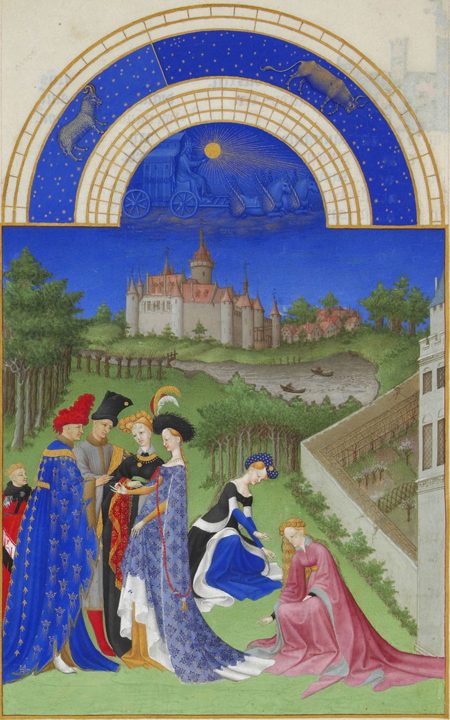 |
|
Illuminated page for the month of April from Les Très Riches Heures du Duc de Berry (1416)
[See a larger image of this image] |
Description
It is early spring and green is the dominant color of the landscape (with blue, black,and red the dominant colors of the aristocrats' clothing). The land is laid out before the castle like a garden. A small village is nestled against the walls of the castle to the right; two men in boats are fishing peacefully in the moat; to the right we can see a garden beginning to bloom with what might be fruit trees with white flowers and several bushes tied up against the wall in a horizontal espalier; in the centre foreground two aristocratic ladies are kneeling picking flowers which are growing wild in the grass; another group of aristocrats dressed in very festive clothes are to the left - a bride and bride groom are choosing a wedding ring laid out on a cushion as the lord and lady preside over the little ceremony. The political meaning of the picture might be as follows: we are witnessing the betrothal in 1410 of Charles d'Orleans and Bonne d'Armagnac, the daughter of Bernard d'Armagnac and the grand-daughter of the Duc de Berry. This is a political alliance between two powerful families who were on opposite sides of the 100 Years War. Thus we see here the illustration of the themes of peace and tranquility in both the natural and political worlds.
Quotation: Lord Kames on enlightened aesthetics of gardening vs. the corrupted taste shown by the absolute monarchs in the gardens of Versailles
As gardening is not an inventive art, but an imitation of nature, or rather nature itself ornamented; it follows necessarily, that every thing unnatural ought to be rejected with disdain. Statues of wild beasts vomiting water, a common ornament in gardens, prevail in those of Versailles. Is that ornament in a good taste? A jet d’eau, being purely artificial, may, without disgust, be tortured into a thousand shapes: but a representation of what really exists in nature, admits not any unnatural circumstance. In the statues of Versailles the artist has displayed his vicious taste without the least colour or disguise. A lifeless statue of an animal pouring out water, may be endured without much disgust: but here the lions and wolves are put in violent action, each has seized its prey, a deer or a lamb, in act to devour; and yet, as by hocus-pocus, the whole is converted into a different scene: the lion, forgetting his prey, pours out water plentifully; and the deer, forgetting its danger, performs the same work: a representation no less absurd than that in the opera, where Alexander the Great after mounting the wall of a town besieged, turns his back to the enemy, and entertains his army with a song.
In gardening, every lively exhibition of what is beautiful in nature has a fine effect: on the other hand, distant and faint imitations are displeasing to every one of taste. The cutting evergreens in the shape of animals, is very ancient; as appears from the epistles of Pliny, who seems to be a great admirer of the conceit. The propensity to imitation gave birth to that practice; and has supported it wonderfully long, considering how faint and insipid the imitation is. But the vulgar, great and small, are entertained with the oddness and singularity of a resemblance, however distant, between a tree and an animal. An attempt in the gardens of Versailles to imitate a grove of trees by a group of jets d’eau, appears, for the same reason, no less childish.
In designing a garden, every thing trivial or whimsical ought to be avoided. Is a labyrinth then to be justified? It is a mere conceit, like that of composing verses in the shape of an axe or an egg: the walks and hedges may be agreeable; but in the form of a labyrinth, they serve to no end but to puzzle: a riddle is a conceit not so mean; because the solution is proof of sagacity, which affords no aid in tracing a labyrinth.
The gardens of Versailles, executed with boundless expence by the best artists of that age, are a lasting monument of a taste the most depraved: the faults above mentioned, instead of being avoided, are chosen as beauties, and multiplied without end. Nature, it would seem, was deemed too vulgar to be imitated in the works of a magnificent monarch; and for that reason preference was given to things unnatural, which probably were mistaken for supernatural. I have often amused myself with a fanciful resemblance between these gardens and the Arabian tales: each of them is a performance intended for the amusement of a great king: in the sixteen gardens of Versailles there is no unity of design, more than in the thousand and one Arabian tales: and, lastly, they are equally unatural; groves of jets d’eau, statues of animals conversing in the manner of Aesop, water issuing out of the mouths of wild beasts, give an impression of fairy-land and witchcraft, no less than diamond-palaces, invisible rings, spells and incantations.
Source: Henry Home, Lord Kames, Elements of Criticism, Edited and with an Introduction by Peter Jones (Indianapolis: Liberty Fund, 2005). 2 vols. Vol. 2. CHAPTER XXIV: "Gardening and Architecture." < /title/1431/66459/1623989>.
May
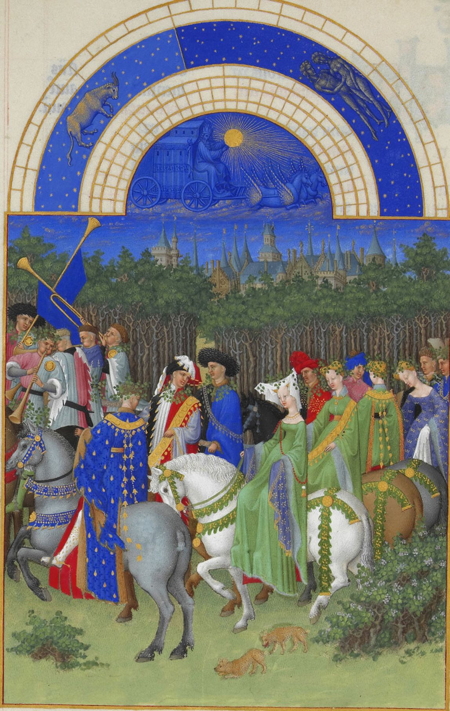 |
|
Illuminated page for the month of May from Les Très Riches Heures du Duc de Berry (1416)
[See a larger image of this image] |
Description
[Material to come]
June
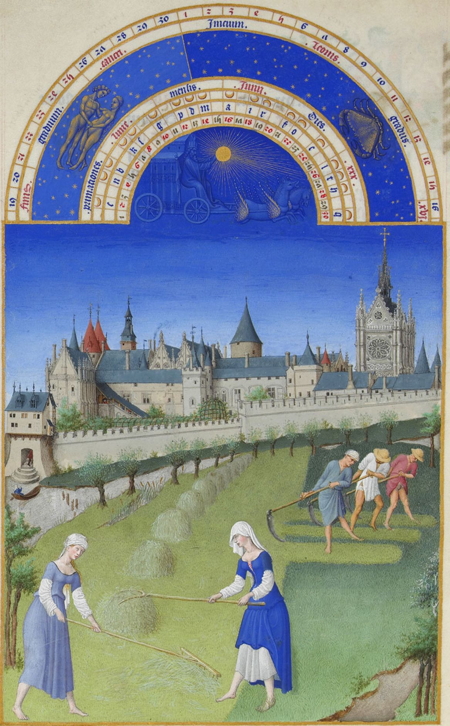 |
|
Illuminated page for the month of June from Les Très Riches Heures du Duc de Berry (1416)
[See a larger image of this image] |
Description
[Material to come]
July
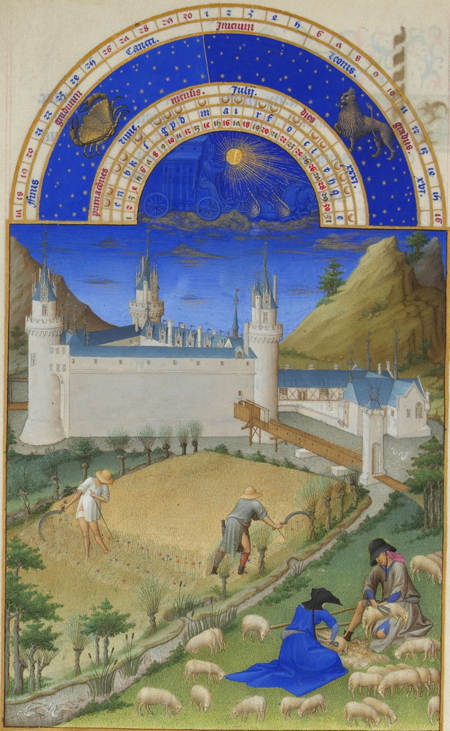 |
|
Illuminated page for the month of July from Les Très Riches Heures du Duc de Berry (1416)
[See a larger image of this image] |
Description
[Material to come]
August
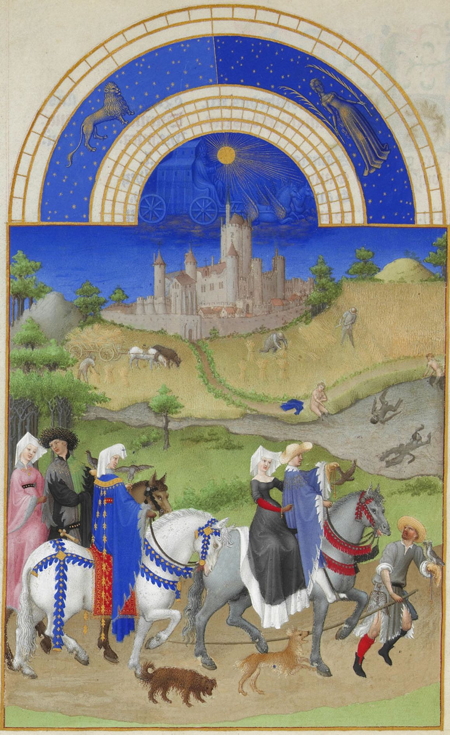 |
|
Illuminated page for the month of August from Les Très Riches Heures du Duc de Berry (1416)
[See a larger image of this image] |
Description
[Material to come]
September
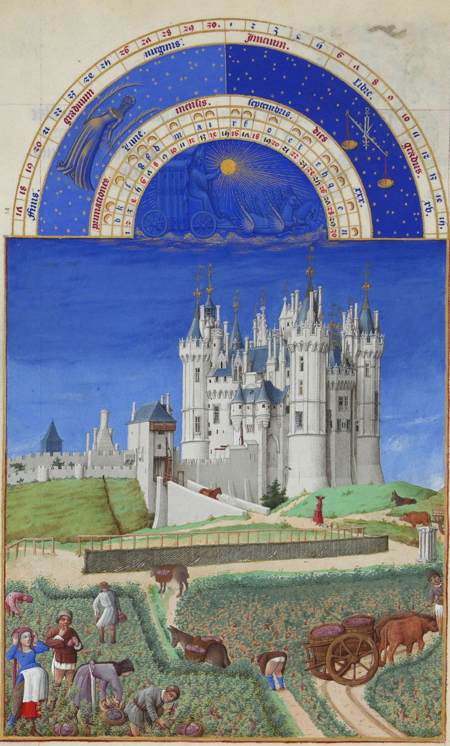 |
|
Illuminated page for the month of September from Les Très Riches Heures du Duc de Berry (1416)
[See a larger image of this image] |
Description
[Material to come]
October
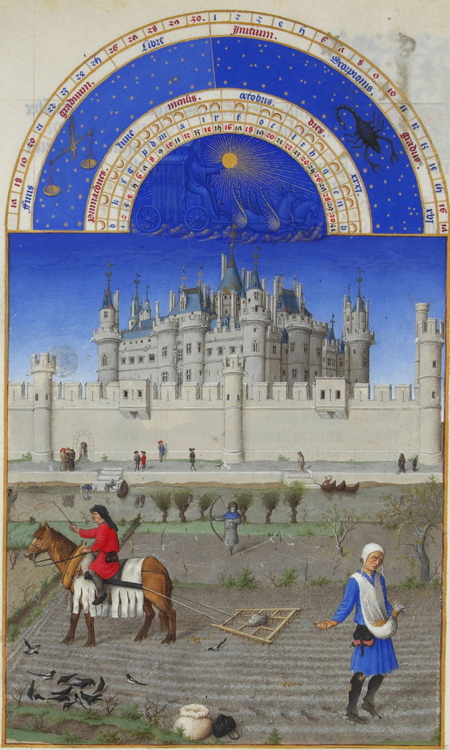 |
|
Illuminated page for the month of October from Les Très Riches Heures du Duc de Berry (1416)
|
Description
[Material to come]
November
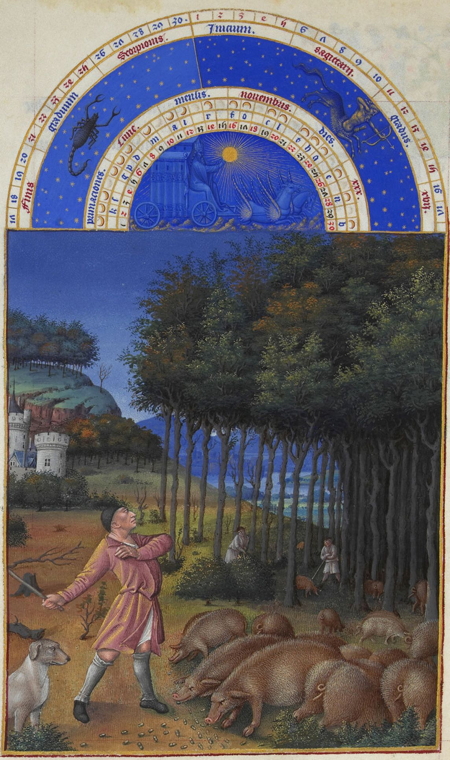 |
|
Illuminated page for the month of November from Les Très Riches Heures du Duc de Berry (1416)
[See a larger image of this image] |
Description
[Material to come]
December
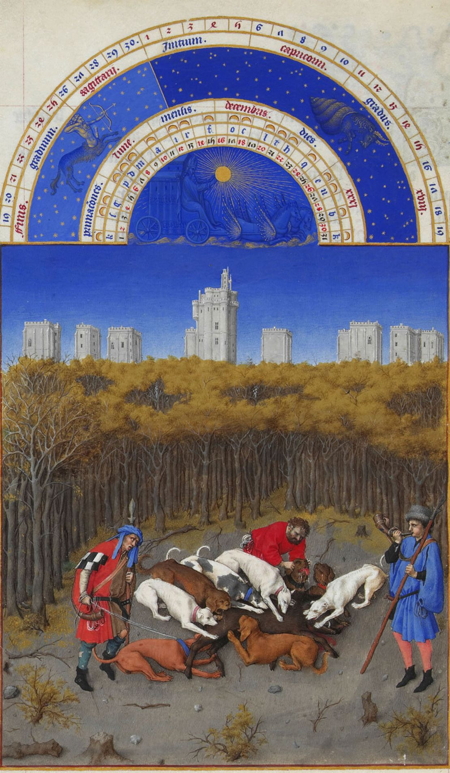 |
|
Illuminated page for the month of December from Les Très Riches Heures du Duc de Berry (1416)
[See a larger image of this image] |
Description
[Material to come]